#azteccivilization
Explore tagged Tumblr posts
Photo

Sun Stone
The Aztec Sun Stone (or Calendar Stone) depicts the five consecutive worlds of the sun from Aztec mythology. The stone is not, therefore, in any sense a functioning calendar, but rather it is an elaborately carved solar disk, which for the Aztecs and other Mesoamerican cultures represented rulership. At the top of the stone is a date glyph (13 reed) which represents both the beginning of the present sun, the 5th and final one according to mythology, and the actual date 1427 CE, thereby legitimizing the rule of Itzcoatl (who took power in that year) and creating a bond between the divine and mankind.
The stone was discovered in December 1790 CE in the central plaza of Mexico City and now resides in the National Museum of Anthropology in that city. The richly carved basalt stone was once a part of the architectural complex of the Temple Mayor and measures 3.58 metres in diameter, is 98 centimetres thick, and weighs 25 tons. The stone would originally have been laid flat on the ground and possibly anointed with blood sacrifices. When it was discovered, the stone was lying flat and upside down, perhaps in an attempt to prevent the final cataclysm - the fall of the 5th and final sun - as the Aztec world fell apart following the attack from the Old World.
At the centre of the stone is a representation of either the sun god Tonatiuh (the Day Sun) or Yohualtonatiuh (the Night Sun) or the primordial earth monster Tlaltecuhtli, in the latter case representing the final destruction of the world when the 5th sun fell to earth. The tongue is perhaps also a sacrificial knife and, sticking out, it suggests a thirst for blood and sacrifice. Around the central face at four points are the other four suns which successively replaced each other after the gods Quetzalcoatl and Tezcatlipoca struggled for control of the cosmos until the era of the 5th sun was reached. The suns are known by the day name on which their final destruction occurred. Beginning from the top right there is the first sun Nahui Ocelotl (4 - Jaguar), top left is the second sun Nahui Ehécatl (4 - Wind), bottom left the third sun Nahui Quiáhuitl (4 - Rain) and bottom right is the fourth sun Nahui Atl (4 - Water).
On either side of the central face are two jaguar heads or paws, each clutching a heart, representing the terrestrial realm. The band running immediately around the suns is segmented into the 20 Aztec day-names (hence the Calendar Stone name). Then there is a decorative ring surrounded by another ring depicting symbols which represent turquoise and jade, symbols of the equinoxes and solstices, and the colours of the heavens. The two heads at the bottom centre represent fire serpents, and their bodies run around the perimeter of the stone with each ending in a tail. The four cardinal and the inter-cardinal directions are also indicated with larger and lesser points respectively.
Continue reading...
168 notes
·
View notes
Photo



(vía "ancient culture, inca woman, beautiful black woman" Photographic Print for Sale by BladiWear)
#redbubble "The splendor of the ancient #Azteccivilization: Exploring its art, its history and its legacy today" #ancientculture, #incawoman, #beautifulblackwoman
1 note
·
View note
Photo

#conquistadores #hernancortes #mexique #azteccivilization #gold #christianhegemony #exploration https://www.instagram.com/p/By6R2DEovmn/?igshid=8cp6v567yn7i
0 notes
Photo

Did we mention that this week's topic is a part of the mythology of one of Myia's favourite parts of the world? #americalatina #latinamerica Bonus, she got to read the #Aztec mito "La creación y los cinco soles", as well as the #PopolVuh. Both of which she owns. In Spanish. Also just this awesome book she got for a few bucks at a yard sale a few years back. Because #ChichenItza #sneakpeeks #mythology #azteccivilization #mayancivilization #quichécivilization #quetzalcoatl #kulkunkan #gukumatz #gods #dioses #serpents https://www.instagram.com/p/Bn1XHWJBlbA/?utm_source=ig_tumblr_share&igshid=1oc77w7be5xw6
#americalatina#latinamerica#aztec#popolvuh#chichenitza#sneakpeeks#mythology#azteccivilization#mayancivilization#quichécivilization#quetzalcoatl#kulkunkan#gukumatz#gods#dioses#serpents
0 notes
Photo

Introducing a Conquistador's worst nightmare. . . The Aztecs
Among Latin American Warfare, no society stands out more in reputation and ability as the Aztecs. The Aztec society was innately linked to war, it was their way of life. They produced the most feared warriors during this time, and engaged in warfare with other civilizations, often dominating the region. Pictured above, a Spaniard come face to face with an elite Aztec Eagle Warrior. Even with their superior weapon technology, the Spanish found a formidable enemy in the Aztecs. From a society that raised warriors from the age of 10 on, the culture and society of the Aztecs was one of war and combat.
6 notes
·
View notes
Photo

Playing as the Aztecs tonight! Tim Going to try a military victory this time. Went up a difficulty level, too. We shall see how this works out. #Civilization #civilization5 #civilizationv #sidmeier #Aztec #montezuma #aztecempire #azteccivilization
0 notes
Photo

The Ball Game of Mesoamerica
The sport known simply as the Ball Game was played by all the major Mesoamerican civilizations and the impressive stone courts became a feature of many cities. More than just a game, it could have a religious significance and featured in episodes of mythology. Contests even supplied candidates for human sacrifice and became literally a game of life or death.
Origins
The game was invented sometime in the Preclassical Period (2500-100 BCE), probably by the Olmec, and became a common Mesoamerican-wide feature of the urban landscape by the Classical Period (300-900 CE). Eventually, the game was even exported to other cultures in North America and the Caribbean.
In Mesoamerican mythology the game is an important element in the story of the Maya gods Hun Hunahpú and Vucub Hunahpú. The pair annoyed the gods of the underworld with their noisy playing and the two brothers were tricked into descending into Xibalba (the underworld) where they were challenged to a ball game. Losing the game, Hun Hunahpús had his head cut off; a foretaste of what would become common practice for players unfortunate enough to lose a game.
In another legend, a famous ball game was held at the Aztec capital of Tenochtitlan between the Aztec king Motecuhzoma Xocoyotzin (r. 1502-1520 CE) and the king of Texcoco. The latter had predicted that Motecuhzoma's kingdom would fall and the game was set-up to establish the truth of this bold prediction. Motecuhzoma lost the game and did, of course, lose his kingdom at the hands of the invaders from the Old World. The story also supports the idea that the ball game was sometimes used for the purposes of divination.
Continue reading...
178 notes
·
View notes
Photo
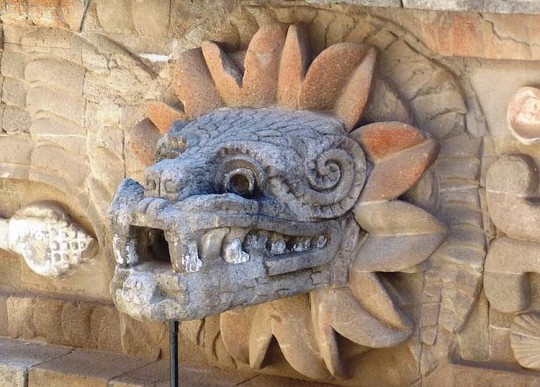
Quetzalcóatl
Quetzalcóatl (pron. Quet-zal-co-at) or 'Plumed Serpent' was one of the most important gods in ancient Mesoamerica. Quetzalcóatl was the god of winds and rain, and the creator of the world and humanity. A mix of bird and rattlesnake, his name is a combination of the Nahuatl words quetzal (the emerald plumed bird) and coatl (serpent).
In Central Mexico from 1200, the feathered serpent god was considered the patron god of priests and merchants as well as the god of learning, science, agriculture, crafts and the arts. He also invented the calendar, was identified with the Morning Star Venus, the rising morning star, he was associated with opossums and even discovered corn (maize) with the help of giant red ant that led him to a mountain packed full of grain and seeds. He was known as Kukulkán to the Maya, Gucumatz to the Quiché of Guatemala, and Ehecatl to the Gulf Coast Huastecs.
Quetzalcóatl was the son of the primordial androgynous god Ometeotl. In Aztec mythology he was the brother of Tezcatlipoca, Huizilopochtli and Xipe Totec. He is the 9th of the 13 Lords of the Day and is often associated with the rain god Tláloc. The god was particularly associated with the sacred site of Cholula, an important place of pilgrimage from 1200, and all round buildings of the Aztec culture were dedicated to the deity.
A Creator God
In the Late Postclassical period (from 1200) in Central Mexico the god came to be strongly associated with the wind (in particular as a bringer of rain clouds) and as the creator god Ehecatl-Quetzalcóatl. In Postclassical Nahua tradition Quetzalcóatl is also the creator of the cosmos along with either his brother Tezcatlipoca or Huitzilopochtli and is one of the four sons of Tonacateuctli and Tonacacihuatl, the original creator gods. After waiting for 600 years this aged couple instructed Quetzalcóatl to create the world. In some versions of the myth Quetzalcóatl and Tezcatlipoca repeatedly fight each other and as a consequence the four ages are created and destroyed with each successive battle between the two gods.
In an alternative version of creation Quetzalcóatl and Tezcatlipoca are more cooperative and together they create the sun, the first man and woman, fire and the rain gods. The pair of gods had created the earth and the sky when they transformed themselves into huge snakes and ripped in two the female reptilian monster known as Tlaltcuhtli (or Cipactli), one part becoming the earth and the other the sky. Trees, plants and flowers sprang from the dead creature's hair and skin whilst springs and caves were made from her eyes and nose and the valleys and mountains came from her mouth. In some versions of the story the divine spirit of Cipactli was understandably upset to have lost her physical body in such a brutal attack and the only way to appease her was through the sacrifice of blood and hearts and so one of the more unpalatable practices of ancient Mesoamerican culture, the ritual of human sacrifice, was justified.
Continue reading...
130 notes
·
View notes
Photo
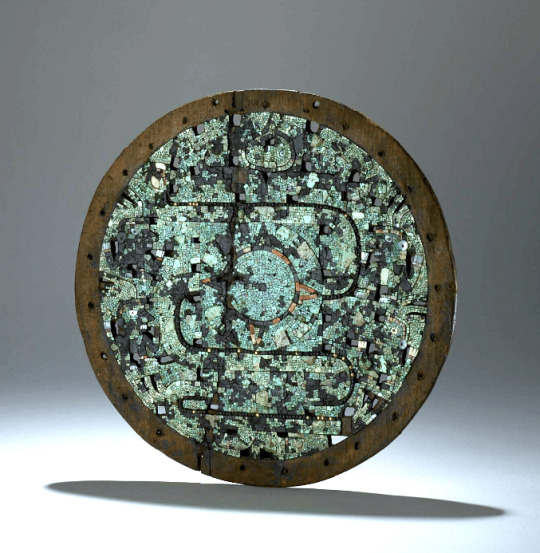
Aztec Turquoise Shield
An Aztec (Mexica) shield of wood covered in turquoise and shell mosaic. Likely used only as a ceremonial shield. The design shows solar disks and a long, winding snake crisscrossing the shield horizontally. The shield was dedicated to the rain god Tlaloc and buried beneath the Templo Mayor at Tenochtitlan. 1400-1521, Mexico. (British Museum, London)
Image by The British Museum
407 notes
·
View notes
Photo
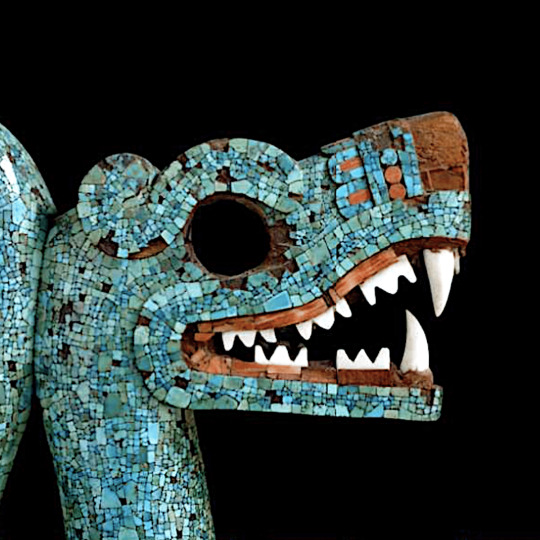
Aztec Religion & Culture
Aztec religion and culture flourished between c. 1345 and 1521 and, at its height, influenced the majority of the people of northern Mesoamerica. Great monarchs such as Montezuma imposed Aztec ideals across the area of modern-day Mexico, influencing the region’s art, architecture, and cultural values. Their influence was so widespread that they remain the best-documented Mesoamerican civilization in history.
This collection presents a brief survey of some of the most significant aspects of the Aztec Civilization.
Continue reading...
115 notes
·
View notes
Photo
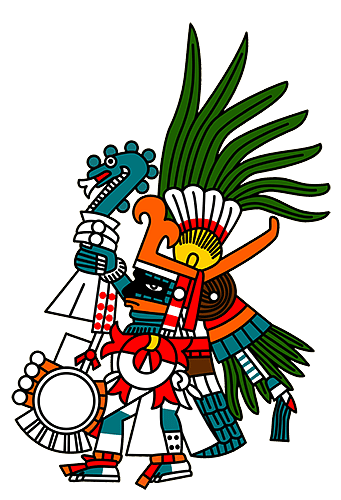
Huitzilopochtli
Huitzilopochtli (pron. Huit-zi-lo-pocht-li) or 'Hummingbird of the South' or 'Blue Hummingbird on the Left' was one of the most important deities in the Aztec pantheon and for the Méxica he was the supreme god. He was the god of the sun and war, considered the patron of the Aztec capital Tenochtitlán and associated with gold, warriors and rulers. His calendar name was Ce Técpatl (1 Flint) and his nagual or animal spirit was the eagle.
Unlike many other Aztec deities, Huitzilopochtli has no clear equivalents from earlier Mesoamerican cultures. In Aztec mythology Huitzilopochtli was the son of Omecίhuatl and Ometecuhtli, respectively, the female and male aspects of the androgynous primordial god Ometeotl. In an alternative version, the god is the offspring of Coatlίcue, the supreme earth goddess. Huitzilopochtli was also considered the brother of those other great Mesoamerican gods Quetzalcoatl, Tezcatlipoca and Xipe Totec.
Huitzilopochtli as the Sun
Huitzilopochtli famously avenged the murder of his mother Coatlίcue (or in some versions actually saved her) when he defeated his siblings the 400 Centzonhuitznahuac and Centzonmimizcoa on Mt. Coatepec, the snake mountain. According to the legend, Coatlίcue, whilst sweeping her temple, tucked some feathers under her breast and with these she became pregnant with Huitzilopochtli. Her children were outraged at this development and attacked Coatlίcue but when they decapitated their mother Huitzilopochtli sprang from the corpse with all his weapons in hand and lopped off his sister Coyolxauhqui's head. In some versions of the myth she had been the leader of the revolt, in others, she had been trying to warn Coatlίcue of the plot against her. In any case, Huitzilopochtli dismembered her corpse so that her torso fell to the bottom of the mountain and when he slung the head into the skies it became the moon. Huitzilpochtli then dealt with his other unruly siblings the Centzonhuitznahuac and the Centzonmimizcoa, putting an end to their takeover attempt and dispersing them into the heavens to become the southern and northern constellations respectively.
For the Aztecs the tussle between Coyolxauhqui and Huitzilopochtli was thought to reoccur everyday which explained the daily exchange for control of the sky between the sun and moon. Huitzilopochtli was believed to be accompanied on the first half of his journey across the sky by the spirits of fallen warriors (who would later return to earth as hummingbirds). From noon the god was then accompanied by the Cihuateteo, the spirits of women who had died during childbirth. When night fell Huitzilopochtli moved through the Underworld until dawn and he then once more travelled the skies.
Continue reading...
75 notes
·
View notes
Photo
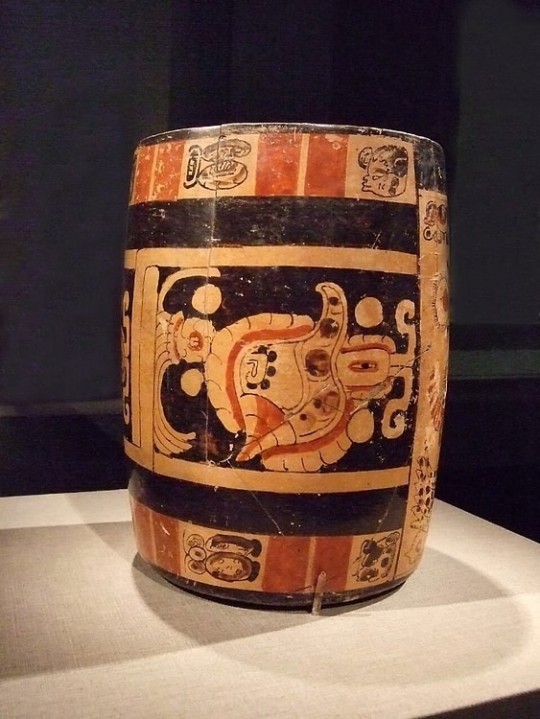
Chocolate in Mesoamerica
Chocolate was one of the most desired foods of Mesoamerica and was consumed by the Olmec, Maya, and Aztec civilizations, amongst others. Its consumption even spread via trade routes to other parts of the Americas including the Chaco Canyon in modern New Mexico. The earliest known use of chocolate was by the Olmec around 1900 BCE and, enjoyed as a drink, it was drunk from special round jars known as tecomates. The Maya used tall cylinder beakers for drinking chocolate, and these very often had text on the rim indicating their intended use. The Aztecs also had richly decorated tall cups specifically reserved for chocolate drinks. It may be that such conspicuous vessels were designed to impress onlookers that the drinker had the means and status to enjoy such a prized drink.
Cultivation & Value
Chocolate is made from the beans of cacao pods from the Theobroma cacao tree (actually native to South America) which was first cultivated in extensive orchards near the Pacific and Gulf coasts of Central America, especially in the Xoconusco region and the valleys of the Sarstoon, Polochic, and Motagua Rivers (modern Guatemala and Belize), where the tree thrives in the warm and humid climate. There were, in fact, four varieties of cacao bean or cacahuatl, as the Aztecs knew them, and the corruption of this word or their term for the chocolate drink - xocolatl - is probably the origin of the word chocolate.
So esteemed was chocolate that beans were a commonly traded item, very often demanded as tribute from subject tribes and even used as a form of currency by the Aztecs. In fact, cacao beans were so valuable that they were even counterfeited either to pass as currency or, even more fiendishly, hollowed out of their valuable interior and refilled with a substitute such as sand. As a currency, we know that in the Aztec markets one cacao bean could buy you a single tomato, 30 beans got you a rabbit and, for the more ambitious shopper, a turkey could be had for 200 beans.
As an expensive import then, chocolate was drunk mainly by the upper classes and consumed after meals, typically accompanied by the smoking of tobacco. It may have been enjoyed mixed with maize gruel by the poorer classes at important events such as weddings, but some scholars maintain that the pure chocolate drink was an exclusive status symbol of the nobility. Curiously, it could even be given to favoured sacrificial victims as a final treat before they departed this world, for example, at the annual Aztec festival of Panquetzaliztli held in honour of Huitzilopochtli.
Continue reading...
24 notes
·
View notes
Photo
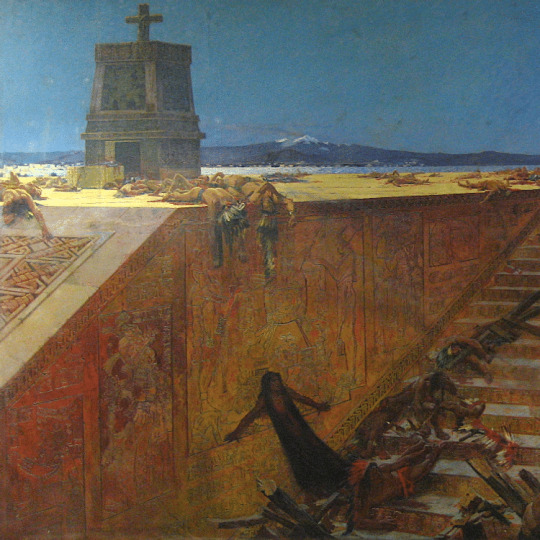
The Fall of Tenochtitlan
The fall of Tenochtitlan on 13 August 1521 was a decisive moment in the dramatic collapse of the Aztec empire which had dominated Mesoamerica. Led by Hernán Cortés (1485-1547), the Spanish conquistadors enjoyed superior weapons and tactics. In addition, the Old World visitors brought with them terrible new diseases that caused massive loss of life amongst the indigenous Americans.
Continue reading...
85 notes
·
View notes
Photo

Aztec Empire Map
A map illustrating the origins and territorial expansion of the Aztec Empire in Mesoamerica between the 14th and 16th centuries.
63 notes
·
View notes